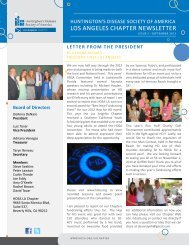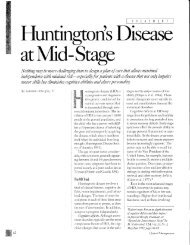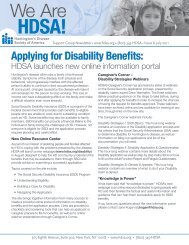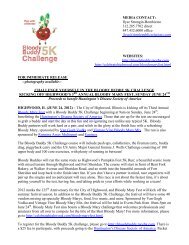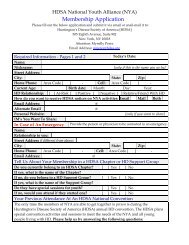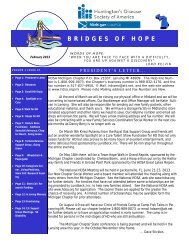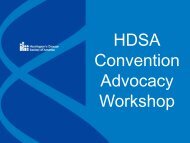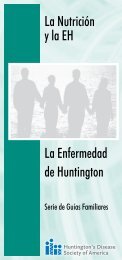Gait & Balance Problems in HD - Huntington's Disease Society of ...
Gait & Balance Problems in HD - Huntington's Disease Society of ...
Gait & Balance Problems in HD - Huntington's Disease Society of ...
You also want an ePaper? Increase the reach of your titles
YUMPU automatically turns print PDFs into web optimized ePapers that Google loves.
CURE<br />
TOWAR D A<br />
WINTER 2009<br />
A R E S E A R C H U P D A T E<br />
World Congress on Hunt<strong>in</strong>gton’s <strong>Disease</strong><br />
Meets <strong>in</strong> Vancouver, BC<br />
September found more than<br />
750 researchers, cl<strong>in</strong>icians,<br />
family members and staff<br />
from <strong>in</strong>ternational <strong>HD</strong><br />
organizations gathered <strong>in</strong><br />
Vancouver for three excit<strong>in</strong>g<br />
days <strong>of</strong> shar<strong>in</strong>g <strong>in</strong>formation,<br />
personal stories and best<br />
practices.<br />
Though the Congress convened<br />
on Sunday, September 13, the<br />
Hunt<strong>in</strong>gton <strong>Society</strong> <strong>of</strong> Canada jump<br />
started the weekend by launch<strong>in</strong>g<br />
Ariel and Ralph Walker Day on<br />
Saturday afternoon. More than 150<br />
participants attended workshops on<br />
youth programm<strong>in</strong>g, capitaliz<strong>in</strong>g on<br />
social network<strong>in</strong>g, <strong>in</strong>novative fund<br />
rais<strong>in</strong>g ideas, stay<strong>in</strong>g strong through<br />
<strong>HD</strong> and more.<br />
Day One<br />
On Sunday, Congress participants<br />
gathered for a formal welcome by<br />
organizer chairs, Michael Hayden<br />
and Blair Leavitt, as well as IHA<br />
president Asuncion Mart<strong>in</strong>ez and<br />
Don Lamont, President <strong>of</strong> the<br />
Hunt<strong>in</strong>gton <strong>Society</strong> <strong>of</strong> Canada.<br />
Thereafter the program featured a<br />
plenary session each morn<strong>in</strong>g with<br />
Scientific and Care Sessions <strong>of</strong>fered<br />
each afternoon. The first plenary<br />
session featured 4 panelists who gave<br />
mov<strong>in</strong>g testimonials to liv<strong>in</strong>g at risk.<br />
On page 3 you will f<strong>in</strong>d a report<br />
on the Scientific Sessions that took<br />
place over the three day Congress.<br />
This article will focus on advances<br />
<strong>in</strong> care and new <strong>in</strong>itiatives that were<br />
announced as part <strong>of</strong> ongo<strong>in</strong>g efforts<br />
by the Euro-<strong>HD</strong> Network to develop<br />
Best Practices for <strong>HD</strong>.<br />
Though the Care Sessions covered<br />
a wealth <strong>of</strong> <strong>in</strong>formation on each<br />
topic, we have provided a snapshot<br />
<strong>of</strong> each workshop.<br />
Care Session One<br />
Lectures focused on “Liv<strong>in</strong>g with<br />
<strong>HD</strong>” and featured Oliver Quarrell<br />
(Liv<strong>in</strong>g with J<strong>HD</strong>), Vicki Wheelock<br />
(Liv<strong>in</strong>g with Early <strong>HD</strong>), Sam Frank<br />
(Liv<strong>in</strong>g with Advanced <strong>HD</strong>), and<br />
Eleanor Wilson (Care at End <strong>of</strong><br />
Life). The ma<strong>in</strong> thrust <strong>of</strong> the session<br />
was to discuss the challenges faced<br />
<strong>in</strong> diagnos<strong>in</strong>g and car<strong>in</strong>g for people<br />
with <strong>HD</strong> both from the cl<strong>in</strong>ical and<br />
family aspects.<br />
Of particular <strong>in</strong>terest <strong>in</strong> the J<strong>HD</strong><br />
discussion was the data that suggested<br />
that many physicians <strong>in</strong>itially blame<br />
the parents for “bad parent<strong>in</strong>g” thus<br />
creat<strong>in</strong>g even further barriers for the<br />
family to clear <strong>in</strong> their quest for a<br />
diagnosis. Quarrell suggested that<br />
In This Issue<br />
Cont<strong>in</strong>ued on page 8<br />
2 Notes from the Lab<br />
3 Scientific Session Highlights<br />
6 <strong>Gait</strong> & <strong>Balance</strong> <strong>Problems</strong> <strong>in</strong> <strong>HD</strong><br />
10 Ways to Give
Notes<br />
from the Lab<br />
By Marcy MacDonald, Ph.D.<br />
Chair, <strong>HD</strong>SA Medical and<br />
Scientific Advisory Committee<br />
We are delighted to br<strong>in</strong>g you this new<br />
issue <strong>of</strong> Toward a Cure. In September,<br />
more than 750 scientists, cl<strong>in</strong>icians and<br />
family members met <strong>in</strong> Vancouver, British<br />
Columbia for four excit<strong>in</strong>g days <strong>of</strong><br />
lectures, workshops and network<strong>in</strong>g.<br />
Family members, scientists and cl<strong>in</strong>icians attended an array <strong>of</strong> presentations<br />
focused on science or care. The scientific sessions showcased the<br />
tremendous strides <strong>in</strong> research that have been made, <strong>in</strong>clud<strong>in</strong>g discussions<br />
on the impact stem cell technology will have on <strong>HD</strong>, ways to <strong>in</strong>terfere<br />
with the disease process, the role <strong>of</strong> hunt<strong>in</strong>gt<strong>in</strong> and so much more. It was<br />
an exhilarat<strong>in</strong>g experience. You can read a synopsis <strong>of</strong> the Scientific<br />
Sessions beg<strong>in</strong>n<strong>in</strong>g on page 3 and, for a more complete report please visit<br />
www.hdsa.org.<br />
In the Care Sessions, attendees heard about the research that is go<strong>in</strong>g<br />
on <strong>in</strong> a cl<strong>in</strong>ical sett<strong>in</strong>g, which <strong>in</strong>cludes studies on gait and balance, the use<br />
<strong>of</strong> alternative therapies such as yoga, and advances along the cont<strong>in</strong>uum <strong>of</strong><br />
care, <strong>in</strong>clud<strong>in</strong>g the early f<strong>in</strong>d<strong>in</strong>gs <strong>of</strong> the European <strong>HD</strong> Network and their<br />
nascent standards <strong>of</strong> care. We are pleased to provide an article on gait and<br />
balance by Sandra Kostyk and members <strong>of</strong> the <strong>HD</strong> team at the Center <strong>of</strong><br />
Excellence at Ohio State University (see page 6).<br />
Importantly, we also heard <strong>in</strong>spirational stories from youth and young<br />
adults – people at-risk, those who tested positive and tested negative –<br />
who <strong>of</strong>fered their own unique perspective on liv<strong>in</strong>g with <strong>HD</strong>. We found<br />
that youth and young adults around the world are f<strong>in</strong>d<strong>in</strong>g ways to<br />
communicate through social network<strong>in</strong>g media such as Facebook and<br />
Twitter. They were eager to share their ideas and to make connections<br />
with others. These future leaders were ask<strong>in</strong>g questions about important<br />
issues, like genetic test<strong>in</strong>g, that challenged many <strong>of</strong> the established<br />
protocols. As we cont<strong>in</strong>ue to advance on many different fronts, their<br />
<strong>in</strong>fluence is sure to be felt.<br />
In clos<strong>in</strong>g, I’d like to recognize two pr<strong>in</strong>cipal World Congress<br />
organizers, Michael Hayden (an <strong>HD</strong>SA Coalition for the Cure<br />
<strong>in</strong>vestigator) and Blair Leavitt, both from the University <strong>of</strong> British<br />
Columbia <strong>in</strong> Vancouver. Their outstand<strong>in</strong>g efforts to ensure that every<br />
participant, whether scientist, cl<strong>in</strong>ician or family member, had workshop<br />
options that suited their level <strong>of</strong> <strong>in</strong>terest, were exceptional and<br />
appreciated by all <strong>in</strong> attendance.<br />
As we end this year, I ask that you make a special effort to support the<br />
research that is so important if we are to f<strong>in</strong>d effective treatments and<br />
eventually a cure for <strong>HD</strong>. Your contribution, large or small, will be greatly<br />
appreciated<br />
TOWAR D ACURE<br />
Published twice yearly, as a public<br />
service, by the Hunt<strong>in</strong>gton’s <strong>Disease</strong><br />
<strong>Society</strong> <strong>of</strong> America Inc.<br />
505 Eighth Avenue, Suite 902<br />
New York, NY 10018<br />
(212) 242-1968 • www.hdsa.org<br />
<strong>HD</strong>SA BOARD OF TRUSTEES<br />
C. Walt Johnston, Chairman <strong>of</strong> the Board<br />
Donald Barr, Vice-Chair <strong>of</strong> the Board<br />
Jamie Greene, Esq., Secretary<br />
Roger Vaughan, Treasurer<br />
Diane Carlson<br />
Jang-Ho Cha, M.D., Ph.D., Chair, CPEAC<br />
Gerry Francese, Esq.<br />
Susan Huang<br />
Steve Ireland<br />
Barry Kahn<br />
Cheryl Kendrick<br />
Marcy MacDonald, Ph.D., Chair, MSAC<br />
Michael Roth, Chair, Market<strong>in</strong>g<br />
Steve Seek<strong>in</strong>s<br />
Kimberly Silva<br />
Leon Tibben, Chair, NFC<br />
Dan Vandivort<br />
Louise Vetter<br />
Chief Executive Officer<br />
Debra Lovecky<br />
Director <strong>of</strong> Education,<br />
Programs and Services<br />
Editor<br />
Laurie Straus, EllEss Design, Inc.<br />
Layout & Design<br />
The purpose <strong>of</strong> Toward a Cure is to provide<br />
<strong>in</strong>formation and op<strong>in</strong>ion and to relay items<br />
<strong>of</strong> <strong>in</strong>terest to <strong>in</strong>dividuals with Hunt<strong>in</strong>gton’s<br />
<strong>Disease</strong> and their families, healthcare<br />
pr<strong>of</strong>essionals and <strong>in</strong>terested friends and<br />
supporters.<br />
The appearance <strong>of</strong> advertis<strong>in</strong>g, or the mention<br />
<strong>of</strong> commercial articles available for sale <strong>in</strong><br />
articles published <strong>in</strong> this newsletter, is not an<br />
<strong>HD</strong>SA, Inc. guarantee or endorsement <strong>of</strong> the<br />
product or the claims made for the product by<br />
the manufacturer. Statements and op<strong>in</strong>ions<br />
expressed <strong>in</strong> articles are not necessarily those<br />
<strong>of</strong> <strong>HD</strong>SA, Inc.<br />
The Hunt<strong>in</strong>gton’s <strong>Disease</strong> <strong>Society</strong> <strong>of</strong><br />
America (<strong>HD</strong>SA) is a national not-for-pr<strong>of</strong>it<br />
organization. The <strong>Society</strong> is dedicated to<br />
eradicat<strong>in</strong>g Hunt<strong>in</strong>gton’s <strong>Disease</strong> by<br />
promot<strong>in</strong>g and support<strong>in</strong>g <strong>HD</strong> research; to<br />
help<strong>in</strong>g families cope with the problems<br />
presented by <strong>HD</strong>; and to educat<strong>in</strong>g the<br />
public and healthcare pr<strong>of</strong>essionals about<br />
Hunt<strong>in</strong>gton’s <strong>Disease</strong>.<br />
.<strong>HD</strong>SA is a member <strong>of</strong> the National Voluntary<br />
Health Agencies, the National Health Council,<br />
the National Organization <strong>of</strong> Rare Disorders,<br />
the International Hunt<strong>in</strong>gton Association,<br />
the Alliance for Genetic Support Groups, and<br />
the Independent Sector.<br />
The Hunt<strong>in</strong>gton’s <strong>Disease</strong> <strong>Society</strong> <strong>of</strong> America<br />
meets all n<strong>in</strong>e standards <strong>of</strong> the National<br />
Charities Information Bureau.<br />
2
Scientific Sessions<br />
Highlights from the World Congress<br />
Session 1 was dedicated to Biomarkers. Ken Evans<br />
(Ontario Cancer Biomarker Network) spoke <strong>of</strong> their<br />
importance and variety, from specific molecules, to<br />
imag<strong>in</strong>g and observational measures. He stressed that<br />
s<strong>in</strong>ce it appears that CAG expansion only accounts for<br />
50 percent <strong>of</strong> the variability <strong>of</strong> age <strong>of</strong> onset, and that<br />
mutant hunt<strong>in</strong>gt<strong>in</strong> is found throughout the entire body,<br />
a systems approach, comb<strong>in</strong><strong>in</strong>g several biomarkers, may<br />
be necessary for accurate assessment <strong>of</strong> the progression<br />
<strong>of</strong> disease and measurement <strong>of</strong> possible treatments.<br />
Stefan Kloppel (Freiburg University, Germany)<br />
reviewed current progress <strong>in</strong> Imag<strong>in</strong>g Biomarkers for<br />
<strong>HD</strong> <strong>in</strong>clud<strong>in</strong>g recent work comb<strong>in</strong><strong>in</strong>g PREDICT<br />
<strong>in</strong>formation, whole bra<strong>in</strong> images, and TRACK-<strong>HD</strong>,<br />
which shows striatal volume loss 20 years prior to<br />
symptom onset. Kloppel noted that a comb<strong>in</strong>ation <strong>of</strong><br />
motor score and functional imag<strong>in</strong>g may be necessary<br />
for more accurate gaug<strong>in</strong>g <strong>of</strong> disease progression.<br />
Ralf Reilmann (University<br />
<strong>of</strong> Muenster, Germany)<br />
followed with a discussion <strong>of</strong><br />
cl<strong>in</strong>ical biomarkers: cognitive,<br />
psychiatric, behavioral and<br />
motor. He spoke <strong>of</strong> the need<br />
for more quantitative measures<br />
than those provided by the<br />
U<strong>HD</strong>RS (Unified Hunt<strong>in</strong>gton’s<br />
<strong>Disease</strong> Rat<strong>in</strong>g Scale), which is<br />
the current standard assessment<br />
<strong>in</strong>strument. His colleagues are<br />
work<strong>in</strong>g on develop<strong>in</strong>g devices<br />
that accurately measure chorea,<br />
bradyk<strong>in</strong>esia, gait, tapp<strong>in</strong>g,<br />
oculomotor and persistency (tongue protrusion) to<br />
confirm and augment the U<strong>HD</strong>RS. Models <strong>of</strong> these<br />
devices are be<strong>in</strong>g tested at E<strong>HD</strong>N sites. Cognitive<br />
markers were the topic <strong>of</strong> Julie Stout’s (Indiana<br />
University) presentation and her work on the “<strong>HD</strong><br />
Toolkit” <strong>in</strong>cluded <strong>in</strong>vestigat<strong>in</strong>g potential measur<strong>in</strong>g<br />
tools that could demonstrate an immediate response,<br />
thus <strong>in</strong>dicat<strong>in</strong>g disease progression as well as possible<br />
detection <strong>of</strong> symptom reduction and disease modification.<br />
Stout also suggested that cognitive markers<br />
should be l<strong>in</strong>ked with functional and quality <strong>of</strong> life<br />
measurements and that regulatory agencies be brought<br />
<strong>in</strong>to this discussion so there is consensus that will aid <strong>in</strong><br />
the approval <strong>of</strong> future therapies.<br />
Session 2 focused on Post-Translational Modifications<br />
<strong>in</strong> <strong>HD</strong> which is a process <strong>in</strong> which prote<strong>in</strong>s, such as the<br />
Real progress has been made <strong>in</strong><br />
stem cell technology, which <strong>of</strong>fers<br />
an excit<strong>in</strong>g new route to<br />
therapeutic development because<br />
it affords opportunities to discover<br />
the specific processes that are<br />
altered by the <strong>HD</strong> mutation <strong>in</strong><br />
different types <strong>of</strong> human cells,<br />
<strong>in</strong>clud<strong>in</strong>g bra<strong>in</strong> cells.<br />
hunt<strong>in</strong>gt<strong>in</strong> prote<strong>in</strong>, are decorated with dynamic<br />
biochemical moieties after they are synthesized.<br />
Sandr<strong>in</strong>e Humbert (Institute Curie, Orsay, France)<br />
spoke on the phosphorylation <strong>of</strong> <strong>HD</strong> function <strong>in</strong> health<br />
and disease. Humbert emphasized that the hunt<strong>in</strong>gt<strong>in</strong><br />
prote<strong>in</strong> is essential for development, survival and the<br />
processes <strong>of</strong> important cellular functions, as well as<br />
be<strong>in</strong>g toxic to neurons <strong>in</strong> its mutant (<strong>HD</strong>-caus<strong>in</strong>g)<br />
state. Her work has shown that phosphorylation at<br />
S421 (an am<strong>in</strong>o acid at position four hundred twenty<br />
one <strong>in</strong> the hunt<strong>in</strong>gt<strong>in</strong> prote<strong>in</strong>) restores BDNF (a<br />
prote<strong>in</strong> <strong>in</strong>volved with neuron growth), and may<br />
therefore be a target for therapeutic <strong>in</strong>tervention.<br />
Joan Steffan (University <strong>of</strong> California at Irv<strong>in</strong>e)<br />
spoke about modify<strong>in</strong>g the first 17 am<strong>in</strong>o acids <strong>in</strong><br />
hunt<strong>in</strong>gt<strong>in</strong> and the process <strong>of</strong> sumoylation. Small<br />
Ubiquit<strong>in</strong>-like Modifier or SUMO prote<strong>in</strong>s attach to<br />
and/or detach from other<br />
prote<strong>in</strong>s <strong>in</strong> cells to modify their<br />
function. SUMOylation is part<br />
<strong>of</strong> many cellular processes,<br />
<strong>in</strong>clud<strong>in</strong>g the movement <strong>of</strong><br />
material with<strong>in</strong> a cell,<br />
transcription and cell death.<br />
Steffan’s lab has found<br />
<strong>in</strong>dications that altered<br />
sumolyation <strong>of</strong> prote<strong>in</strong>s may<br />
affect the progression <strong>of</strong> disease<br />
<strong>in</strong> <strong>HD</strong> model systems.<br />
Proteolysis (the “digestion” <strong>of</strong><br />
prote<strong>in</strong>s by cellular enzymes<br />
called proteases or by <strong>in</strong>tramolecular<br />
digestion) <strong>of</strong> hunt<strong>in</strong>gt<strong>in</strong> <strong>in</strong> the development <strong>of</strong><br />
<strong>HD</strong> was the topic <strong>of</strong> Rona Graham’s talk (University<br />
<strong>of</strong> British Columbia). She described her work on C6R<br />
YAC transgenic mice, which express a version <strong>of</strong><br />
human hunt<strong>in</strong>gt<strong>in</strong> that has been mutated so that the<br />
prote<strong>in</strong> cannot be cleaved by an enzyme (caspase 6) at<br />
a specific position near the start <strong>of</strong> the prote<strong>in</strong>. Caspase<br />
6 has also been identified <strong>in</strong> neurodegeneration <strong>in</strong><br />
Alzheimer’s and Park<strong>in</strong>son’s disease. Dmitri Kra<strong>in</strong>c<br />
(Massachusetts General Hospital) talked about<br />
acetylation <strong>of</strong> mutant hunt<strong>in</strong>gt<strong>in</strong> and how it may<br />
modulate the degradation <strong>of</strong> prote<strong>in</strong>s by a process called<br />
autophagy (self-eat<strong>in</strong>g). Dr. Kra<strong>in</strong>c is study<strong>in</strong>g whether<br />
prote<strong>in</strong> deactylation <strong>in</strong>hibitors could reverse the<br />
Cont<strong>in</strong>ued on page 4<br />
3
Scientific Session Highlights (cont’d from page 3)<br />
degradation <strong>of</strong> cell components caused by the mutant<br />
hunt<strong>in</strong>gt<strong>in</strong> prote<strong>in</strong>.<br />
Real progress has been made <strong>in</strong> stem cell technology,<br />
which <strong>of</strong>fers an excit<strong>in</strong>g new route to therapeutic<br />
development because it affords opportunities to discover<br />
the specific processes that are altered by the <strong>HD</strong> mutation<br />
<strong>in</strong> different types <strong>of</strong> human cells, <strong>in</strong>clud<strong>in</strong>g bra<strong>in</strong> cells.<br />
Jamshid Arjomand (C<strong>HD</strong>I) gave an overview <strong>of</strong> the<br />
state <strong>of</strong> stem cell research <strong>in</strong> <strong>HD</strong>, start<strong>in</strong>g with the variety<br />
<strong>of</strong> ways stem cells may be cultivated: fetal, neural, nonneural,<br />
embryonic, IPS (<strong>in</strong>duced pluripotent stem cells),<br />
and neurospheres (free float<strong>in</strong>g cell structures generated by<br />
neural cells). While stem cells may be used sometime <strong>in</strong><br />
the future <strong>in</strong> ‘replacement’ therapies to treat or prevent<br />
<strong>HD</strong>, the work currently underway uses stem cells as tools<br />
for discovery research. To date both mouse and human<br />
embryonic stem cells, with<br />
expanded CAG repeats, have<br />
been successfully developed.<br />
Anseme Perrier<br />
(InSerm/I-Stem, Evry, France)<br />
spoke about generat<strong>in</strong>g<br />
striatal neurons from monkey<br />
embryonic stem cells, and the<br />
potential for allograft<br />
transplantation (transplantation<br />
<strong>of</strong> cells from another<br />
person). While there has been some success <strong>in</strong> early<br />
experiments, it is clear that, as <strong>in</strong> other stem cell<br />
transplantation efforts, the transplantation alone will not<br />
be enough – neuroprotective methods need to be<br />
developed to prevent side effects, such as the tumors that<br />
occurred <strong>in</strong> some early experiments.<br />
Neural stem cells grown <strong>in</strong> culture reta<strong>in</strong><br />
some <strong>of</strong> their native characteristics and<br />
can be manipulated to <strong>in</strong>duce different<br />
patterns <strong>of</strong> gene expression that are<br />
characteristic <strong>of</strong> different types <strong>of</strong><br />
specialized bra<strong>in</strong> cells – excit<strong>in</strong>g!<br />
<strong>of</strong> specialized bra<strong>in</strong> cells – excit<strong>in</strong>g!<br />
For years scientists have known that some aspect <strong>of</strong><br />
mitochondrial dysfunction (loss <strong>of</strong> a cell’s ability to produce<br />
energy) was a significant factor <strong>in</strong> <strong>HD</strong>. In Scientific<br />
Session 4, Patrick Weydte (University <strong>of</strong> Ulm, Germany)<br />
discussed the relationship between dysregulation <strong>of</strong> gene<br />
transcription and mutant hunt<strong>in</strong>gt<strong>in</strong> <strong>in</strong> the bra<strong>in</strong>, and <strong>in</strong><br />
muscle and fat tissue, through a master regulator prote<strong>in</strong>,<br />
PGC-1 alpha, suggest<strong>in</strong>g that a better understand<strong>in</strong>g <strong>of</strong><br />
this prote<strong>in</strong> may be a way to retard the progress <strong>of</strong> the<br />
disease. Marcy MacDonald (Massachusetts General<br />
Hospital) reviewed her work <strong>in</strong> rul<strong>in</strong>g out the significant<br />
direct impact <strong>of</strong> mitochondrial respiration which was done<br />
us<strong>in</strong>g human samples as well as hunt<strong>in</strong>gt<strong>in</strong> knockout and<br />
hunt<strong>in</strong>gt<strong>in</strong> CAG knock-<strong>in</strong> mice and cell l<strong>in</strong>es.<br />
MacDonald expla<strong>in</strong>ed how the hunt<strong>in</strong>gt<strong>in</strong> prote<strong>in</strong><br />
may be regulat<strong>in</strong>g how<br />
carbon molecules <strong>in</strong> sugars<br />
are utilized by cells and how<br />
altered metabolism may be<br />
connected to other problems<br />
that mutant cells have.<br />
Ali Koshnan (California<br />
Institute <strong>of</strong> Technology) then<br />
talked about <strong>in</strong>flammatory<br />
cytok<strong>in</strong>es (substances emitted<br />
by immune system cells that<br />
send signals to other cells)<br />
which are elevated <strong>in</strong> the bra<strong>in</strong>s <strong>of</strong> people with <strong>HD</strong> as<br />
early as 16 years before they become symptomatic. He<br />
described work be<strong>in</strong>g done to understand the function <strong>of</strong><br />
one <strong>of</strong> the <strong>in</strong>flammatory cytok<strong>in</strong>es, IKK, which has been<br />
found to <strong>in</strong>hibit the neurotoxicity <strong>of</strong> mutant hunt<strong>in</strong>gt<strong>in</strong> <strong>in</strong><br />
mice by regulat<strong>in</strong>g the cleavage <strong>of</strong> the prote<strong>in</strong>.<br />
Clive Svendsen (Cedars-S<strong>in</strong>ai Medical Center and<br />
University <strong>of</strong> Wiscons<strong>in</strong>) spoke about us<strong>in</strong>g human neural<br />
stem cells that can be genetically manipulated prior to<br />
transplantation to <strong>in</strong>crease the likelihood <strong>of</strong> creat<strong>in</strong>g new<br />
neural cells. Human neural stem cells from fetal bra<strong>in</strong><br />
tissue have been used to reduce symptoms <strong>in</strong> a rat model<br />
<strong>of</strong> <strong>HD</strong>, and those that have been eng<strong>in</strong>eered to produce<br />
factors that <strong>in</strong>crease the well-be<strong>in</strong>g <strong>of</strong> bra<strong>in</strong> cells (GDNF<br />
and IGF1) have shown improved symptoms <strong>in</strong> N171<br />
transgenic mice. How to generate large numbers <strong>of</strong> neural<br />
stem cell l<strong>in</strong>es for both research and therapeutic<br />
development was the subject that was addressed by Elena<br />
Cattaneo (University <strong>of</strong> Milano, Italy). She has focused<br />
on develop<strong>in</strong>g a renewable source <strong>of</strong> neural stem cells that<br />
can be manipulated <strong>in</strong> various ways. Neural stem cells<br />
grown <strong>in</strong> culture reta<strong>in</strong> some <strong>of</strong> their native characteristics<br />
and can be manipulated to <strong>in</strong>duce different patterns <strong>of</strong><br />
gene expression that are characteristic <strong>of</strong> different types<br />
Microglia (non-neuron cells <strong>in</strong>volved <strong>in</strong> signal<br />
transmission that act as the immune system <strong>of</strong> the central<br />
nervous system) are approximately 10% <strong>of</strong> all bra<strong>in</strong> cells,<br />
but less than 1% <strong>of</strong> our RNA. Thomas Moeller<br />
(University <strong>of</strong> Wash<strong>in</strong>gton) spoke about discover<strong>in</strong>g<br />
elevated levels <strong>of</strong> neuro-<strong>in</strong>flammatory substances <strong>in</strong> the<br />
bra<strong>in</strong>s <strong>of</strong> people with <strong>HD</strong> and suggested that the role <strong>of</strong><br />
<strong>in</strong>flammation be exam<strong>in</strong>ed more closely, as well as<br />
whether mutant hunt<strong>in</strong>gt<strong>in</strong> affects microglia transcription<br />
or functionality. Indeed, the <strong>HD</strong> disease process leads to<br />
significant loss <strong>of</strong> bra<strong>in</strong> volume, as well as atrophy and the<br />
death <strong>of</strong> neurons. New studies show that even many years<br />
before symptom onset there is a loss <strong>of</strong> grey and white<br />
bra<strong>in</strong> matter, and that the loss <strong>of</strong> cognitive function is<br />
related to synaptic plasticity (change <strong>in</strong> strength <strong>of</strong> the<br />
connection between two neurons). Marian DiFiglia<br />
(Massachusetts General Hospital) spoke about the<br />
problems caused by mutant hunt<strong>in</strong>gt<strong>in</strong> when they localize<br />
4
<strong>in</strong> cell membranes and affect the signal<strong>in</strong>g pathways <strong>of</strong><br />
membranes that regulate growth and survival. DiFiglia’s<br />
studies suggest that mutant hunt<strong>in</strong>gt<strong>in</strong> impairs the<br />
development <strong>of</strong> these signal<strong>in</strong>g mechanisms, which may<br />
be valid targets for therapeutic <strong>in</strong>tervention.<br />
Erich Wanker (Max Delbruck Center for Molecular<br />
Medic<strong>in</strong>e, Germany) shared his work on identify<strong>in</strong>g<br />
substances that modulate misfold<strong>in</strong>g <strong>of</strong> polyglutam<strong>in</strong>e and<br />
other aggregation-prone prote<strong>in</strong>s that can elicit toxicity<br />
<strong>in</strong> <strong>HD</strong> model systems. He has looked at the accumulation<br />
<strong>of</strong> <strong>in</strong>soluble prote<strong>in</strong>s (amyloids) and has determ<strong>in</strong>ed that<br />
CRMP1 expression (a prote<strong>in</strong> that is part <strong>of</strong> the neural<br />
development process) decreased polyglutam<strong>in</strong>eaggregation<br />
<strong>in</strong> Drosophila (fruit fly) and may be a<br />
worthwhile target for therapeutic <strong>in</strong>tervention.<br />
Sirtu<strong>in</strong>s are a family <strong>of</strong> prote<strong>in</strong> deactylases that retard<br />
the ag<strong>in</strong>g process <strong>in</strong> experiments <strong>in</strong>volv<strong>in</strong>g calorie<br />
restriction. In mouse models, calorie restriction seemed to<br />
<strong>in</strong>crease sirtu<strong>in</strong> activity and has been shown to be<br />
protective <strong>in</strong> <strong>HD</strong> model systems. Dena Cohen<br />
(Massachusetts Institute <strong>of</strong> Technology) has <strong>in</strong>vestigated<br />
whether <strong>in</strong>creased expression <strong>of</strong> Sirt1 would prevent the<br />
progression <strong>of</strong> <strong>HD</strong> <strong>in</strong> the R6/2 mouse model. Her work<br />
suggests that the overexpression <strong>of</strong> Sirt1 extends life and<br />
protects aga<strong>in</strong>st striatal atrophy <strong>in</strong> that mouse model.<br />
Sirt1 regulates BDNF (bra<strong>in</strong> derived neurotrophic factor),<br />
a key prote<strong>in</strong> <strong>in</strong> nerve cell growth and function, so<br />
regulation <strong>of</strong> Sirt1 may become a valuable therapeutic<br />
approach to the treatment <strong>of</strong> <strong>HD</strong>. Lynn Raymond<br />
(University <strong>of</strong> British Columbia) rounded out the session<br />
with a discussion <strong>of</strong> excitotoxicity,<br />
a process by which nerve cells<br />
become damaged as a result <strong>of</strong><br />
over-activation by neurotransmitters.<br />
There are many potential<br />
causes <strong>of</strong> excitotoxicity <strong>in</strong> <strong>HD</strong>,<br />
<strong>in</strong>clud<strong>in</strong>g mitochondrial<br />
dysfunction, dopam<strong>in</strong>e-mediated<br />
signal<strong>in</strong>g, the release <strong>of</strong> calcium, as<br />
well as altered glutamate-signal<strong>in</strong>g<br />
<strong>in</strong> mutant hunt<strong>in</strong>gt<strong>in</strong> express<strong>in</strong>g neurons. There may also<br />
be a relationship between enhanced NMDAR (an am<strong>in</strong>o<br />
acid that acts as a b<strong>in</strong>d<strong>in</strong>g agent <strong>in</strong> NMDA receptors), as<br />
experiments <strong>in</strong> YAC mice have shown that <strong>in</strong>creased<br />
NDMAR signal<strong>in</strong>g may trigger cell death pathways,<br />
which suggests that these processes may be a fruitful<br />
approach to an <strong>HD</strong> therapy.<br />
The f<strong>in</strong>al Scientific Session <strong>of</strong> the World Congress<br />
<strong>in</strong>cluded presentations <strong>of</strong> new approaches aimed at<br />
understand<strong>in</strong>g and develop<strong>in</strong>g therapies for <strong>HD</strong>. The purpose<br />
<strong>of</strong> the session was to communicate these <strong>in</strong>itial f<strong>in</strong>d<strong>in</strong>gs<br />
For years scientists have known<br />
that some aspect <strong>of</strong> mitochondrial<br />
dysfunction (loss <strong>of</strong> a cell’s ability<br />
to produce energy) was a<br />
significant factor <strong>in</strong> <strong>HD</strong>.<br />
to the assembled scientists and<br />
foster conversations that would<br />
lead to further<br />
<strong>in</strong>vestigation <strong>of</strong><br />
promis<strong>in</strong>g<br />
avenues <strong>of</strong><br />
research.<br />
Holly<br />
Kordasiewicz<br />
(University <strong>of</strong> San Diego)<br />
described her research us<strong>in</strong>g antisense oligonucleotide<br />
(ASO) mediated suppression <strong>of</strong> hunt<strong>in</strong>gt<strong>in</strong> as a treatment<br />
for <strong>HD</strong>. ASOs are short s<strong>in</strong>gle stranded DNAs that target<br />
specific RNA for chemical destruction.<br />
Pierre Kystkowiak (on behalf <strong>of</strong> the Hunt<strong>in</strong>gton<br />
French Speak<strong>in</strong>g Network) presented a study <strong>in</strong>volv<strong>in</strong>g<br />
Adenos<strong>in</strong>e A2A Receptors, which are localized on sp<strong>in</strong>y<br />
neurons that express enkephal<strong>in</strong> and D2 receptors (the<br />
most vulnerable <strong>in</strong> <strong>HD</strong> which affect striatal<br />
development), and the role they play <strong>in</strong> the onset <strong>of</strong> <strong>HD</strong>.<br />
Nellie Georgiou-Karistianis (Monash University,<br />
Australia) studied the potential <strong>of</strong> magnetic resonance<br />
(MR) phase signals as a measurement <strong>of</strong> iron concentration<br />
<strong>in</strong> the caudate and putamen <strong>in</strong> <strong>HD</strong> patients.<br />
Increases <strong>in</strong> iron concentration <strong>in</strong> these areas occur <strong>in</strong><br />
<strong>HD</strong> patients and so this study may lead to the creation <strong>of</strong><br />
a valid biomarker. There has been much discussion about<br />
the validity <strong>of</strong> mouse models <strong>in</strong> <strong>HD</strong> research. Simon<br />
Brooks (Cardiff University, Wales) described a series <strong>of</strong><br />
experiments that supported the use <strong>of</strong> the YAC-128<br />
mouse as a model <strong>of</strong> human cognitive deficits that occur<br />
as the disease progresses. Juliet<br />
God<strong>in</strong> (University <strong>of</strong> Orsay,<br />
France) presented f<strong>in</strong>d<strong>in</strong>gs that<br />
beta-caten<strong>in</strong> (a prote<strong>in</strong> <strong>in</strong>volved<br />
<strong>in</strong> cell-cell communication)<br />
accumulates <strong>in</strong> <strong>HD</strong> cell and<br />
fruitfly models, as well as <strong>in</strong><br />
samples from deceased <strong>HD</strong><br />
patients.<br />
The f<strong>in</strong>al presentation was a review <strong>of</strong> PGD<br />
(preimplantation genetic diagnosis) by Alison Lashwood<br />
(St. Thomas Hospital, London). Over the past seven<br />
years, 83 PGD cycles were attempted, result<strong>in</strong>g <strong>in</strong> the<br />
birth <strong>of</strong> 28 healthy babies, <strong>of</strong> which 6 sets were tw<strong>in</strong>s.<br />
The Hospital considers this a successful record, and noted<br />
the importance <strong>of</strong> expert counsel<strong>in</strong>g prior to the decision<br />
to undergo PGD treatment. With the proliferation <strong>of</strong><br />
genetic advances, the <strong>HD</strong> PGD program also serves as an<br />
important model for ethical and scientific issues that<br />
surround the process.<br />
5
<strong>Gait</strong> &<strong>Balance</strong> <strong>Problems</strong> <strong>in</strong> <strong>HD</strong><br />
Assessment and Interventions<br />
<strong>Gait</strong> and balance problems<br />
become a grow<strong>in</strong>g concern<br />
over time for <strong>in</strong>dividuals with<br />
Hunt<strong>in</strong>gton’s <strong>Disease</strong> (<strong>HD</strong>).<br />
Falls and <strong>in</strong>juries result <strong>in</strong><br />
<strong>in</strong>creas<strong>in</strong>g impairment and<br />
the loss <strong>of</strong> <strong>in</strong>dependence.<br />
Fall prevention becomes a<br />
challenge. Because muscle<br />
strength is preserved <strong>in</strong> <strong>HD</strong>,<br />
and because it is hard for<br />
<strong>in</strong>dividuals to understand<br />
why they can not just get<br />
up and go all the time,<br />
especially when most <strong>of</strong> the<br />
time they do not fall,<br />
treat<strong>in</strong>g balance disorders<br />
<strong>in</strong> <strong>HD</strong> can be difficult<br />
Sandra Kostyk, M.D., Ph.D.,<br />
Deb Kegelmeyer PT, DPT, GCS and<br />
Ann Kloos PT, Ph.D., NCS<br />
Most neurologists are not specifically tra<strong>in</strong>ed <strong>in</strong> how to assess gait and<br />
balance disorders. While physical therapists have more experience <strong>in</strong><br />
tra<strong>in</strong><strong>in</strong>g <strong>in</strong>dividuals <strong>in</strong> safe walk<strong>in</strong>g techniques and <strong>in</strong> the use <strong>of</strong> assistive<br />
devices, few therapists <strong>in</strong> general practice have had much experience with<br />
the specific needs <strong>of</strong> the person with <strong>HD</strong>. Little research has been done on<br />
gait and balance problems <strong>in</strong> neurodegenerative disorders and even less has<br />
been done <strong>in</strong> <strong>HD</strong>. Work<strong>in</strong>g as a team over the last five years, we have tried<br />
to figure out how to assess who is at risk for falls and how assistive devices<br />
affect balance and gait <strong>in</strong> <strong>in</strong>dividuals with <strong>HD</strong>. Recently, we have begun<br />
try<strong>in</strong>g to f<strong>in</strong>d ways to use exercise therapy to improve balance and gait.<br />
The standard motor assessment tool used <strong>in</strong> <strong>HD</strong> is the Unified<br />
Hunt<strong>in</strong>gton’s <strong>Disease</strong> Rat<strong>in</strong>g Scale (U<strong>HD</strong>RS). The scale is useful for<br />
assess<strong>in</strong>g disease severity and disease progression. However, it has only three<br />
measures <strong>of</strong> gait and balance and they are not very helpful for assess<strong>in</strong>g fall<br />
risks. After review<strong>in</strong>g other available cl<strong>in</strong>ical scales and measures, we<br />
selected the T<strong>in</strong>etti Mobility Test (TMT) to study gait and balance <strong>in</strong> <strong>HD</strong> <strong>in</strong><br />
more detail. The TMT scores 9 balance measures and 10 gait measures and<br />
can be adm<strong>in</strong>istered <strong>in</strong> less than 5 m<strong>in</strong>utes. We rout<strong>in</strong>ely asked <strong>in</strong>dividuals<br />
<strong>in</strong> cl<strong>in</strong>ic how many falls they had <strong>in</strong> the week before their cl<strong>in</strong>ic visit and<br />
how many falls they estimated they had <strong>in</strong> the last 6 months. Most patients<br />
also had the TMT test performed dur<strong>in</strong>g their visits. A review <strong>of</strong> 193 medical<br />
charts was completed. Falls reported ranged from 0-35 <strong>in</strong> the previous week<br />
to 0-500 <strong>in</strong> the previous 6 months. With 28<br />
represent<strong>in</strong>g a normal score on the TMT, we<br />
found that TMT scores below 21 were<br />
associated with impaired motor function<br />
(worse U<strong>HD</strong>RS scores) and slower gait<br />
speed and with a l<strong>in</strong>early <strong>in</strong>creas<strong>in</strong>g fall risk<br />
as the TMT score decreased. Individuals<br />
who score below 21 warrant further<br />
assessment, education and <strong>in</strong>terventions to<br />
decrease risk and frequency <strong>of</strong> falls.<br />
In addition to try<strong>in</strong>g<br />
to identify who is<br />
likely to fall and<br />
which devices work<br />
best to support<br />
mobility and<br />
stability, we have<br />
begun look<strong>in</strong>g at<br />
approaches to<br />
improve balance and<br />
coord<strong>in</strong>ation <strong>in</strong> <strong>HD</strong>.<br />
Indentify<strong>in</strong>g who is likely to beg<strong>in</strong> hav<strong>in</strong>g<br />
trouble with falls helps <strong>in</strong> plann<strong>in</strong>g<br />
<strong>in</strong>tervention strategies. One <strong>of</strong> the most<br />
common <strong>in</strong>terventions is the <strong>in</strong>troduction<br />
<strong>of</strong> an assistive device. It is commonly agreed<br />
that <strong>in</strong>dividuals with <strong>HD</strong> do not generally<br />
do well with canes. This may be <strong>in</strong> part because <strong>of</strong> the phenomena <strong>of</strong> motor<br />
impersistence (the tendency <strong>of</strong> not ma<strong>in</strong>ta<strong>in</strong><strong>in</strong>g a motor position such as the<br />
hand grasp needed to cont<strong>in</strong>uously hold on to the cane) or <strong>in</strong> part because <strong>of</strong><br />
the vary<strong>in</strong>g motions associated with chorea. However, the effectiveness <strong>of</strong><br />
vary<strong>in</strong>g types <strong>of</strong> canes and walkers has not been well explored <strong>in</strong> <strong>HD</strong>. We<br />
recruited 21 subjects <strong>in</strong> various stages <strong>of</strong> <strong>HD</strong> to try out 7 different assistive<br />
devices. The devices <strong>in</strong>cluded a regular cane, a weighted cane, a standard<br />
6
Figure 1. <strong>Gait</strong>Rite computerized<br />
record <strong>of</strong> steps <strong>of</strong> three <strong>in</strong>dividuals.<br />
The upper trac<strong>in</strong>g shows the typical<br />
shuffl<strong>in</strong>g, small step pattern <strong>of</strong> an<br />
<strong>in</strong>dividual with Park<strong>in</strong>son’s <strong>Disease</strong>.<br />
Note that you can draw a straight<br />
l<strong>in</strong>e from one step to the next. The<br />
middle trac<strong>in</strong>g is from a normal<br />
healthy <strong>in</strong>dividual. Aga<strong>in</strong>, you can<br />
draw a straight l<strong>in</strong>e follow<strong>in</strong>g the<br />
right foot pr<strong>in</strong>t across the walkway.<br />
The bottom trac<strong>in</strong>g is from an<br />
<strong>in</strong>dividual with Hunt<strong>in</strong>gton’s disease<br />
with a mild gait impairment who has<br />
not had problems with falls.<br />
However, notice that there is a lot <strong>of</strong><br />
variability <strong>in</strong> step direction and<br />
spac<strong>in</strong>g between steps.<br />
walker, a two wheeled walker, a three wheeled walker and a<br />
four wheeled walker. Each person was then assessed walk<strong>in</strong>g<br />
with each device. <strong>Gait</strong> patterns were electronically<br />
recorded and transferred to a computerized data system<br />
while each <strong>in</strong>dividual walked 64 ft. Figure 1 shows an<br />
example <strong>of</strong> how the gait patterns can be recorded us<strong>in</strong>g the<br />
<strong>Gait</strong>Rite system. Mobility and maneuverability were also<br />
assessed with each device while walk<strong>in</strong>g repeatedly <strong>in</strong> a<br />
figure-<strong>of</strong>-eight pattern around two chairs. Multiple gait<br />
variables were measured and compared <strong>in</strong>clud<strong>in</strong>g gait<br />
speed, stride length, base <strong>of</strong> support, sw<strong>in</strong>g time and<br />
number <strong>of</strong> stumbles. We found that all devices slowed gait<br />
speed compared to the <strong>in</strong>dividual’s spontaneous normal<br />
gait. This slow<strong>in</strong>g <strong>of</strong> gait speed may <strong>in</strong> part be why some<br />
<strong>in</strong>dividuals resist us<strong>in</strong>g assistive devices. However, us<strong>in</strong>g the<br />
three and four wheeled walkers most closely approached<br />
normal gait speed. All devices but the three wheeled<br />
walker decreased normal stride length. Although<br />
<strong>in</strong>dividuals walked faster with the three wheeled walker on<br />
a straight path, the three wheeled walker <strong>in</strong>creased the<br />
amount <strong>of</strong> time that an <strong>in</strong>dividual’s feet were both on the<br />
ground and <strong>in</strong>creased step variability. In addition, it took<br />
them longer to complete the figure-<strong>of</strong>-eight obstacle course<br />
than with any other device. The worst gait patterns<br />
observed were with the standard walker (no wheels), the<br />
two wheeled walker and the two canes. Overall, the device<br />
that produced the most normal gait pattern with the<br />
greatest stability was the four wheeled walker with front<br />
swivel wheels and hand brakes. Introduc<strong>in</strong>g the four<br />
wheeled walker as the TMT score beg<strong>in</strong>s to fall below 21,<br />
and before the onset <strong>of</strong> frequent falls, and may help get the<br />
<strong>in</strong>dividual with <strong>HD</strong> acclimated to the device and facilitate<br />
mobility, <strong>in</strong>dependence and safety.<br />
In addition to try<strong>in</strong>g to identify who is likely to fall and<br />
which devices work best to support mobility and stability,<br />
we have begun look<strong>in</strong>g at approaches to improve balance<br />
and coord<strong>in</strong>ation <strong>in</strong> <strong>HD</strong>. We rout<strong>in</strong>ely provide our patients<br />
with a DVD and exercise booklet with balance and gait<br />
exercises specifically geared to the <strong>in</strong>dividual with <strong>HD</strong>.<br />
However, while it is hard for the unaffected <strong>in</strong>dividual to<br />
exercise regularly, even though we all know it is for our own<br />
good, apathy and fear <strong>of</strong> fall<strong>in</strong>g can be an even greater<br />
barrier to regular exercise for those with <strong>HD</strong>. In an effort to<br />
explore ways to <strong>in</strong>corporate balance and coord<strong>in</strong>ation<br />
workouts <strong>in</strong>to an easily applicable exercise rout<strong>in</strong>e that<br />
might also be fun, we have begun study<strong>in</strong>g the use <strong>of</strong> a<br />
therapist guided application <strong>of</strong> the Dance Dance Revolution<br />
as a delivery system for a Video game Bi<strong>of</strong>eedback<br />
modulated Exercise program (the ViBE study). We hope to<br />
determ<strong>in</strong>e if regular use can improve balance, decrease fall<br />
risk and improve quality <strong>of</strong> life <strong>in</strong> <strong>in</strong>dividuals with <strong>HD</strong>.<br />
After a brief learn<strong>in</strong>g curve everyone who has participated<br />
so far has improved the correct number <strong>of</strong> steps performed<br />
dur<strong>in</strong>g the dance program and everyone has enjoyed participat<strong>in</strong>g.<br />
Prelim<strong>in</strong>ary data suggests that TMT scores may<br />
improve <strong>in</strong> some subjects after the 6 week course. Formal<br />
data analysis will beg<strong>in</strong> on this project after the last three<br />
subjects complete the study. In the meantime, as data<br />
suggests that regular exercise may prevent progression <strong>of</strong><br />
several neurodegenerative diseases, we encourage everyone<br />
to try to exercise at least three times a week.<br />
Acknowledgements and references are available upon request.<br />
SK Kostyk, MD, PhD, DA Kegelmeyer, PT, DPT, GCS and AD<br />
Kloos PT, PhD, NCS; The <strong>HD</strong>SA Center <strong>of</strong> Excellence at the Ohio<br />
State University.<br />
7
World Congress on <strong>HD</strong> meets <strong>in</strong> Vancouver (cont’d from page 1)<br />
the diagnostic process needs to be reassessed<br />
so it <strong>in</strong>cludes parental and<br />
family support rather than just<br />
medication <strong>of</strong> symptoms.<br />
In Liv<strong>in</strong>g with Early <strong>HD</strong>,<br />
Wheelock presented evidence from<br />
both the PREDICT-<strong>HD</strong> and<br />
TRACK-<strong>HD</strong> studies that <strong>in</strong>dicate<br />
that <strong>HD</strong> is a life-long process that<br />
can be detected many years before<br />
diagnosis. She noted that people<br />
at risk for <strong>HD</strong> should not wait for<br />
a def<strong>in</strong>itive diagnosis <strong>of</strong><br />
<strong>HD</strong> but rather proactively<br />
assemble a care team early,<br />
educate themselves about<br />
<strong>HD</strong> <strong>in</strong>clud<strong>in</strong>g treatments,<br />
develop strategies to help<br />
with behavioral changes,<br />
beg<strong>in</strong> exercise and nutrition<br />
programs, and volunteer for research<br />
studies.<br />
Sam Frank looked at Liv<strong>in</strong>g with<br />
Advanced <strong>HD</strong> and the impact small<br />
<strong>in</strong>terventions <strong>in</strong> supportive homes<br />
and long term care facilities can<br />
have on quality <strong>of</strong> life. He <strong>in</strong>cluded<br />
prepar<strong>in</strong>g <strong>in</strong> advance, manag<strong>in</strong>g<br />
medications, establish<strong>in</strong>g rout<strong>in</strong>es<br />
and <strong>in</strong>troduc<strong>in</strong>g ancillary therapies<br />
such as physical and occupational<br />
therapy, speech therapy, music and<br />
art, and likened the person with <strong>HD</strong><br />
as be<strong>in</strong>g the center spoke <strong>in</strong> the<br />
wheel around which family, cl<strong>in</strong>ical<br />
care and treatment issues rotated.<br />
Wilson touched upon the<br />
challenges <strong>of</strong> deliver<strong>in</strong>g palliative and<br />
end <strong>of</strong> life care to the person with<br />
<strong>HD</strong>. Both the <strong>in</strong>dividual with <strong>HD</strong><br />
and the family are faced with a<br />
complex range <strong>of</strong> needs at end <strong>of</strong> life.<br />
Advance care plann<strong>in</strong>g is key, and<br />
she recommended develop<strong>in</strong>g best<br />
practices to enhance the quality <strong>of</strong><br />
palliative and end <strong>of</strong> life care for <strong>HD</strong><br />
and other long term neurological<br />
conditions.<br />
Care Session Two<br />
Presenters focused on Approaches<br />
to Symptomatic Therapy for <strong>HD</strong> and<br />
featured Berry Kremer (Symptomatic<br />
Therapy <strong>of</strong> <strong>HD</strong> Associated<br />
Movement Disorders), Sandra<br />
Kostyk (Assessment and<br />
Interventions for <strong>Gait</strong> and <strong>Balance</strong><br />
<strong>Problems</strong> Associated with <strong>HD</strong>),<br />
Adam Rosenblatt (Psychiatric<br />
Symptoms <strong>of</strong> <strong>HD</strong> – Description and<br />
Management and Ira Shoulson<br />
(Irritability and Aggression <strong>in</strong> <strong>HD</strong>:<br />
Cl<strong>in</strong>ical Features and Medical<br />
Management).<br />
Both the <strong>in</strong>dividual with <strong>HD</strong> and the<br />
family are faced with a complex range<br />
<strong>of</strong> needs at end <strong>of</strong> life.<br />
Kremer’s presentation discussed<br />
the benefits <strong>of</strong> earlier <strong>in</strong>tervention<br />
<strong>in</strong> symptom management. However<br />
s<strong>in</strong>ce most treatments for the<br />
movement disorders associated with<br />
<strong>HD</strong> (chorea, dystonia, myoclonus,<br />
rigidity, bradyk<strong>in</strong>esia and ‘clums<strong>in</strong>ess’)<br />
are based on “expert” op<strong>in</strong>ion or<br />
cl<strong>in</strong>ical use rather than evidenced<br />
based studies, she cautioned that the<br />
decision to start medication for the<br />
movement disorder should be<br />
carefully considered.<br />
Kostyk presented an <strong>in</strong>terest<strong>in</strong>g<br />
workshop on gait and balance that<br />
demonstrated that the use <strong>of</strong> three<br />
and four wheeled walkers with front<br />
swivel castors provided the most<br />
efficient, consistent and safe gait<br />
patterns on both a straight walk and<br />
dur<strong>in</strong>g turns. The study also found<br />
that the standard four legged walker<br />
was the worse for people with <strong>HD</strong><br />
(see article on page 6).<br />
Rosenblatt noted that the<br />
psychiatric symptoms <strong>of</strong> <strong>HD</strong> can be<br />
effectively treated with medication.<br />
Depression is present <strong>in</strong> almost 40%<br />
<strong>of</strong> people with <strong>HD</strong> yet rema<strong>in</strong>s<br />
under-diagnosed. Mania is present is<br />
4-8% <strong>of</strong> people with <strong>HD</strong> and may<br />
actually be irritability. Perseveration<br />
is very common, as are delusions.<br />
Though there are a large number <strong>of</strong><br />
medications available to treat the<br />
psychiatric disorders associated with<br />
<strong>HD</strong>, the selection rema<strong>in</strong>s one <strong>of</strong><br />
cl<strong>in</strong>ician preference <strong>in</strong> the absence<br />
<strong>of</strong> evidence based studies. However,<br />
<strong>of</strong> note was the fact that not every<br />
psychiatric/unusual behavior requires<br />
treatment.<br />
Shoulson closed the session with<br />
a presentation on irritability and<br />
aggression and noted that both<br />
are commonly observed and<br />
can be a source <strong>of</strong> significant<br />
disability to both the person<br />
with <strong>HD</strong> and their caregiver.<br />
Cognitive changes that <strong>in</strong>clude<br />
slowed process<strong>in</strong>g, reduced<br />
awareness, difficulty plann<strong>in</strong>g/<br />
sequenc<strong>in</strong>g, and decreased judgment<br />
contribute to irritability and<br />
aggression. Unrecognized/ untreated<br />
depression can also lead to irritability.<br />
Shoulson <strong>in</strong>cluded the role <strong>of</strong> the<br />
family and cop<strong>in</strong>g strategies for<br />
address<strong>in</strong>g the triggers to irritability<br />
and aggression.<br />
Day one <strong>of</strong> the World Congress<br />
concluded with a debate on<br />
Predictive Test<strong>in</strong>g for <strong>HD</strong>: Should It Be<br />
Offered to Children. Speak<strong>in</strong>g on<br />
behalf <strong>of</strong> early test<strong>in</strong>g, Mart<strong>in</strong><br />
Delatycki, made a cogent case for<br />
allow<strong>in</strong>g test<strong>in</strong>g <strong>in</strong> mature m<strong>in</strong>ors<br />
and establish<strong>in</strong>g a m<strong>in</strong>imum age <strong>in</strong><br />
the IHA genetic test<strong>in</strong>g guidel<strong>in</strong>es at<br />
which a m<strong>in</strong>or can be tested. The<br />
current guidel<strong>in</strong>es restrict test<strong>in</strong>g to<br />
“an <strong>in</strong>dividual who has reached the<br />
age <strong>of</strong> majority.” Fiona Richards<br />
provided commentary aga<strong>in</strong>st early<br />
predictive test<strong>in</strong>g and spoke about<br />
the psychological harm that could<br />
come from a positive test result. She<br />
favored reta<strong>in</strong><strong>in</strong>g a m<strong>in</strong>imum age <strong>of</strong><br />
18 as it recognizes adult autonomy<br />
without the risk <strong>of</strong> harm <strong>in</strong>herent <strong>in</strong><br />
the reliance on the arbitrary and<br />
variable “maturity” assessments<br />
proposed by those who favor test<strong>in</strong>g<br />
adolescents younger than age 18.<br />
8
Day Two<br />
The World Congress began with<br />
a plenary session that focused on a<br />
review <strong>of</strong> what we can learn from<br />
other diseases. Featured speakers<br />
<strong>in</strong>cluded Michael Benatar from ALS,<br />
Julio Montaner from HIV/AIDS and<br />
Dale Bredesen from Alzheimer’s<br />
disease. The crux <strong>of</strong> this plenary<br />
session was to look at lessons learned<br />
by these groups <strong>in</strong> their search for<br />
effective treatments. There are many<br />
similarities between <strong>HD</strong> and other<br />
disease groups, not only <strong>in</strong> the way<br />
the disease manifests but also <strong>in</strong> how<br />
research has led to effective<br />
treatments.<br />
Care Session Three<br />
Speakers highlighted Euro-<strong>HD</strong><br />
Network’s efforts to establish<br />
standards <strong>of</strong> care for European <strong>HD</strong><br />
cl<strong>in</strong>ics and <strong>in</strong>cluded presentations<br />
on nutrition, speech, neuropsychology<br />
and physiotherapy.<br />
Lillian Campos <strong>in</strong>troduced the<br />
concept <strong>of</strong> standards <strong>of</strong> care as they<br />
related to the nutritional needs <strong>of</strong><br />
people with <strong>HD</strong>. Campos discussed<br />
the impact <strong>of</strong> early <strong>in</strong>tervention to<br />
improve nutritional outcomes <strong>in</strong><br />
people with <strong>HD</strong>, and the importance<br />
<strong>of</strong> <strong>in</strong>clud<strong>in</strong>g the dietician <strong>in</strong> the<br />
multidiscipl<strong>in</strong>ary team approach.<br />
Such early <strong>in</strong>tervention would<br />
prevent weight loss associated with<br />
<strong>HD</strong> and help to def<strong>in</strong>e malnutrition.<br />
S<strong>in</strong>ce nutritional needs vary through<br />
early, mid and later stages, regular<br />
reviews are important and would<br />
encourage forward plann<strong>in</strong>g<br />
<strong>in</strong>clud<strong>in</strong>g use <strong>of</strong> feed<strong>in</strong>g tubes.<br />
Anne-Wil Heemskerk presented<br />
on early <strong>in</strong>tervention for speech and<br />
swallow<strong>in</strong>g assessments. As a member<br />
<strong>of</strong> the multidiscipl<strong>in</strong>ary team, the<br />
Speech-Language Pathologist (SLP)<br />
would aid the person with <strong>HD</strong> by<br />
assess<strong>in</strong>g their ability to communicate<br />
and swallow. The Standards <strong>of</strong> Care<br />
Workgroup is develop<strong>in</strong>g evidence<br />
based guidel<strong>in</strong>es for best practices <strong>in</strong><br />
the areas <strong>of</strong> speech/language and<br />
dysphagia (swallow<strong>in</strong>g).<br />
Kirsty Matheson discussed the<br />
role <strong>of</strong> neuropsychology and the use<br />
<strong>of</strong> a basel<strong>in</strong>e neuropsychological<br />
assessment at diagnosis and then at<br />
regular <strong>in</strong>tervals to track changes.<br />
The data would be useful <strong>in</strong> behavior<br />
management and when plann<strong>in</strong>g<br />
management strategies. Matheson<br />
provided a few strategy examples that<br />
<strong>in</strong>cluded short tasks/breaks, repeat<strong>in</strong>g<br />
<strong>in</strong>formation, alter<strong>in</strong>g the environment<br />
when needed, identify<strong>in</strong>g strengths<br />
and us<strong>in</strong>g calendars.<br />
Monica Busse concluded the<br />
session with a presentation on<br />
Cont<strong>in</strong>ued on page 10<br />
<strong>HD</strong>Trials.org<br />
<strong>HD</strong>Trials is a Cl<strong>in</strong>ical Trials Recruitment Website that<br />
developed <strong>in</strong> collaboration with members <strong>of</strong> other organizations<br />
and <strong>in</strong>dividuals from the Hunt<strong>in</strong>gton’s <strong>Disease</strong><br />
community. The site allows people to anonymously receive<br />
<strong>in</strong>formation about cl<strong>in</strong>ical studies and cl<strong>in</strong>ical trials that will<br />
be tak<strong>in</strong>g place <strong>in</strong> their geographic area. To register, one need<br />
only visit hdtrials.org, sign up with an email and enter your zip<br />
code or postal code (for Canadians). Researchers and<br />
cl<strong>in</strong>icians notify the adm<strong>in</strong>istrators <strong>of</strong> <strong>HD</strong>Trials <strong>of</strong> their plans,<br />
and emails are then sent to everyone registered with<strong>in</strong> the<br />
appropriate geographic area, <strong>in</strong>form<strong>in</strong>g them <strong>of</strong> the proposed<br />
trial with <strong>in</strong>formation on how to contact the adm<strong>in</strong>istrators <strong>of</strong><br />
the trial.<br />
With the number <strong>of</strong> new potential therapies enter<strong>in</strong>g cl<strong>in</strong>ical trials, there is a rapidly expand<strong>in</strong>g<br />
need for more volunteer participants than ever before – a need that will cont<strong>in</strong>ue to grow with each<br />
new advance. At the same time, we understand the need to protect the privacy <strong>of</strong> members <strong>of</strong> the<br />
<strong>HD</strong> community. The <strong>HD</strong>Trials system was designed to satisfy both the need to expand the number <strong>of</strong><br />
participants <strong>in</strong> studies and trials, while ma<strong>in</strong>ta<strong>in</strong><strong>in</strong>g confidentiality for everyone <strong>in</strong>volved. While<br />
<strong>HD</strong>Trials is adm<strong>in</strong>istered by <strong>HD</strong>SA, the database <strong>of</strong> people who register is kept on secure servers,<br />
apart from those used by <strong>HD</strong>SA or any other <strong>HD</strong> organization.<br />
On the <strong>HD</strong>Trials.org website you will f<strong>in</strong>d more <strong>in</strong>formation on cl<strong>in</strong>ical studies, and trials, l<strong>in</strong>ks to<br />
all <strong>of</strong> the participat<strong>in</strong>g <strong>HD</strong> organizations as well, as l<strong>in</strong>ks to websites where you can obta<strong>in</strong> a free<br />
anonymous email account. Please go to <strong>HD</strong>Trials.org and register today.<br />
9
World Congress<br />
on <strong>HD</strong> meets <strong>in</strong><br />
Vancouver (cont’d from page 9)<br />
physiotherapy for people with <strong>HD</strong>. Aga<strong>in</strong><br />
the discussion centered on early<br />
<strong>in</strong>tervention to improve mobility. Busse<br />
noted that about 19% <strong>of</strong> people with <strong>HD</strong><br />
<strong>in</strong> Europe receive physiotherapy. Benefits<br />
<strong>of</strong> preventive PT <strong>in</strong>clude better balance<br />
and endurance, while restorative PT can<br />
<strong>in</strong>clude gait tra<strong>in</strong><strong>in</strong>g and exercise.<br />
Quantitative studies are underway to<br />
evaluate current physiotherapy practices<br />
and guide the development <strong>of</strong><br />
<strong>in</strong>terventions for people with <strong>HD</strong>.<br />
Care Session Four<br />
Lecturers looked a Improv<strong>in</strong>g Quality<br />
<strong>of</strong> Life for People with <strong>HD</strong>. Presenters<br />
<strong>in</strong>cluded Aileen Ho (<strong>HD</strong> <strong>in</strong> the Home:<br />
Understand<strong>in</strong>g Patient and Carer<br />
Perspectives), Cath Stanley (Improv<strong>in</strong>g<br />
Quality <strong>of</strong> Life), Ruth Veenhuizen<br />
(Outreach<strong>in</strong>g Coord<strong>in</strong>ated Multidiscipl<strong>in</strong>ary<br />
Care for <strong>HD</strong>) and Laura Jean<br />
Kokoska (Improv<strong>in</strong>g Quality <strong>of</strong> Life<br />
Through Kundal<strong>in</strong>i Yoga and Meditation).<br />
Ho explored the impact <strong>HD</strong> has on<br />
both the person affected and the caregiver.<br />
She found a correlation between mood,<br />
cognition and social <strong>in</strong>teractions for both.<br />
Stanley talked about the network <strong>of</strong><br />
regional care advisors that has been<br />
established <strong>in</strong> the UK to work with and<br />
for people affected by <strong>HD</strong>. Early results<br />
<strong>in</strong>dicate that this has improved quality <strong>of</strong><br />
life for people with <strong>HD</strong>.<br />
Veenhuizen discussed a multidiscipl<strong>in</strong>ary<br />
team care approach for people with <strong>HD</strong>.<br />
This is very similar to the <strong>HD</strong>SA Center <strong>of</strong><br />
Excellence concept where<strong>in</strong> all services are<br />
<strong>of</strong>fered <strong>in</strong> a central cl<strong>in</strong>ic and care plans are<br />
created for implementation <strong>in</strong> coord<strong>in</strong>ation<br />
with the primary care provider.<br />
Kokoska demonstrated the benefits <strong>of</strong><br />
yoga and meditation for people with <strong>HD</strong>.<br />
She has conducted similar workshops at<br />
<strong>HD</strong>SA conventions.<br />
Day 2 concluded with a debate about<br />
the use <strong>of</strong> mouse studies as <strong>in</strong>dicators <strong>of</strong><br />
Ways to Give<br />
<strong>HD</strong>SA is an organization that strives to<br />
make every dollar count.Your generosity<br />
has allowed us to develop programs<br />
that positively impact the lives <strong>of</strong> people<br />
with <strong>HD</strong>. With your cont<strong>in</strong>ued support<br />
we will expand these programs to help<br />
to make a difference <strong>in</strong> the lives <strong>of</strong><br />
people with <strong>HD</strong>.<br />
Your donations help us fulfill<br />
the three parts <strong>of</strong> our mission<br />
to improve the lives <strong>of</strong> people<br />
with <strong>HD</strong> and their families:<br />
To f<strong>in</strong>d effective treatments and<br />
ultimately a cure for <strong>HD</strong> by fund<strong>in</strong>g<br />
<strong>in</strong>novative research<br />
To help people with <strong>HD</strong> and their<br />
families by fund<strong>in</strong>g Centers <strong>of</strong><br />
Excellence, social workers, support<br />
groups, chapters and affiliates<br />
To educate the public and healthcare<br />
pr<strong>of</strong>essionals about <strong>HD</strong> by provid<strong>in</strong>g<br />
<strong>in</strong>formation and education about<br />
<strong>HD</strong> to families and healthcare<br />
pr<strong>of</strong>essionals through publications,<br />
books, conferences, conventions,<br />
local and national helpl<strong>in</strong>es and a<br />
national website (www.hdsa.org).<br />
Cont<strong>in</strong>ued on page 12<br />
10
There are many ways for you to make your contribution to <strong>HD</strong>SA.<br />
Visit our website regularly and browse the <strong>HD</strong>SA<br />
Holiday Marketplace for unique holiday gifts.<br />
Purchase colorful amaryllis plants, commemorative<br />
snowflake ornaments, holiday cards, warm and<br />
comfortable fleece pullovers, <strong>in</strong>spirational books and<br />
so much more. There are gifts for every member <strong>of</strong><br />
your family and, best <strong>of</strong> all, your purchases help to<br />
support <strong>HD</strong>SA’s programs for research and care. So this<br />
year, please consider giv<strong>in</strong>g a gift that keeps on giv<strong>in</strong>g.<br />
Please visit www.hdsa.org and click on “To Make<br />
a Donation to <strong>HD</strong>SA click here!” This will take<br />
you to a secure page where you can make a direct<br />
donation to <strong>HD</strong>SA. Or, you can pr<strong>in</strong>t out the form and<br />
mail it to: <strong>HD</strong>SA, 505 Eighth Avenue, Suite 902, New<br />
York, NY 10018, or fax it to 212 216-9004.<br />
You may choose to establish a Family Fund to honor<br />
your family or remember a loved one. Jo<strong>in</strong> with friends<br />
and relatives, and pool your resources, to make your<br />
dollars work harder than you could <strong>in</strong>dividually. What a<br />
wonderful way to honor a loved one dur<strong>in</strong>g the holidays<br />
and throughout the year.<br />
Other options <strong>in</strong>clude the <strong>HD</strong>SA Heritage Club:<br />
create a planned giv<strong>in</strong>g opportunity; <strong>HD</strong>SA Tribute<br />
Gift: honor a friend or relative <strong>in</strong> a special holiday<br />
greet<strong>in</strong>g; or an <strong>HD</strong>SA Memorial Gift: honor the<br />
memory <strong>of</strong> a loved one dur<strong>in</strong>g the holidays.<br />
Your employer may be part <strong>of</strong> the <strong>HD</strong>SA Match<strong>in</strong>g<br />
Gifts Program which doubles your donation. If your<br />
employer is not listed on our website, we can enroll<br />
your company or organization. It’s another way for you<br />
to help <strong>HD</strong>SA, now, and <strong>in</strong> the future.<br />
In addition to these cash gifts you can help<br />
<strong>HD</strong>SA through a donation <strong>of</strong>:<br />
Appreciated Stocks and/or Mutual Funds –<br />
earn a charitable tax deduction for the full fair<br />
market value <strong>of</strong> the gift while you lower your capital<br />
ga<strong>in</strong>s taxes.<br />
Life Insurance – donat<strong>in</strong>g a life <strong>in</strong>surance policy<br />
will earn you an <strong>in</strong>come tax deduction equal to the<br />
lesser <strong>of</strong> the cash value <strong>of</strong> the policy or total<br />
premiums paid.<br />
Real Estate – a gift <strong>of</strong> a property that is fully paid<br />
<strong>of</strong>f will allow you to remove that asset from your<br />
taxable estate. You can then deduct the fair market<br />
value <strong>of</strong> your gift while avoid<strong>in</strong>g all capital ga<strong>in</strong>s<br />
taxes on the property. Transfer the deed <strong>of</strong> your home<br />
or farm to <strong>HD</strong>SA now and reta<strong>in</strong> the right to use the<br />
property for your lifetime and that <strong>of</strong> your spouse.<br />
Will or Trust – a charitable bequest left to<br />
<strong>HD</strong>SA. Ask your attorney to <strong>in</strong>clude word<strong>in</strong>g<br />
such as: “I give, devise, or bequeath all (or note any<br />
fraction or percentage) <strong>of</strong> the rema<strong>in</strong>der <strong>of</strong> my<br />
estate, whether real or personal, to the Hunt<strong>in</strong>gton’s<br />
<strong>Disease</strong> <strong>Society</strong> <strong>of</strong> America, Inc., 505 Eighth<br />
Avenue, Suite 902, New York, NY 10018 for its<br />
general purposes.” OR “I give to the Hunt<strong>in</strong>gton’s<br />
<strong>Disease</strong> <strong>Society</strong> <strong>of</strong> America, 505 Eighth Avenue,<br />
Suite 902, New York, NY 10018, the sum <strong>of</strong><br />
______ dollars to be used for its general purposes.”<br />
For more <strong>in</strong>formation on donat<strong>in</strong>g any <strong>of</strong> these<br />
f<strong>in</strong>ancial <strong>in</strong>struments, please contact the <strong>HD</strong>SA<br />
National Office, 800 345-<strong>HD</strong>SA (4372).<br />
Now more than ever, we need your help. Please use the envelope<br />
enclosed with this issue to make your donation today<br />
11
World Congress on <strong>HD</strong> meets <strong>in</strong> Vancouver<br />
(cont’d from page 10)<br />
success <strong>in</strong> human cl<strong>in</strong>ical trials.<br />
Joseph Guiliano from C<strong>HD</strong>I<br />
advocated on behalf <strong>of</strong> discover<strong>in</strong>g<br />
new methods to test potential<br />
therapies and shift<strong>in</strong>g the use <strong>of</strong> a<br />
mouse model from predict<strong>in</strong>g success<br />
<strong>of</strong> a treatment to confirm<strong>in</strong>g a<br />
mechanism <strong>of</strong> the disease. Fl<strong>in</strong>t Beal<br />
argued the other side – that animal<br />
models have played a critical role <strong>in</strong><br />
provid<strong>in</strong>g accurate and accessible<br />
systems to study the neurobiological<br />
aspects <strong>of</strong> <strong>HD</strong> and serve as a way to<br />
validate known drug targets.<br />
Day Three<br />
The f<strong>in</strong>al day <strong>of</strong> the World<br />
Congress opened with a plenary<br />
session devoted to explor<strong>in</strong>g<br />
potential therapies for <strong>HD</strong> that<br />
<strong>in</strong>cluded an overview <strong>of</strong> the <strong>HD</strong><br />
discovery pipel<strong>in</strong>e by Robert<br />
Pacifici (C<strong>HD</strong>I), and presentations<br />
on <strong>HD</strong>AC 4 (Gillian Bates) and<br />
Dimebon (Sarah Noonberg and<br />
Karl Kieburtz) as possible new<br />
drugs mak<strong>in</strong>g their way through<br />
the pipel<strong>in</strong>e.<br />
Care Session Five<br />
Presentations looked at Cop<strong>in</strong>g<br />
Strategies for <strong>HD</strong> Families and<br />
featured a look at a long term care<br />
facility for people with <strong>HD</strong> (Carol<br />
Herren: The View from Ontario<br />
Shores), Strategies for Cop<strong>in</strong>g with<br />
the Behavioral Symptoms <strong>of</strong> <strong>HD</strong><br />
(David Cauford), a workshop on<br />
how young adults <strong>in</strong> Canada have<br />
been brought together us<strong>in</strong>g social<br />
network<strong>in</strong>g (Brynne Sta<strong>in</strong>sby:<br />
Strategies to Form Connections),<br />
and an <strong>in</strong>spirational story about fund<br />
rais<strong>in</strong>g by Warren Evans (Life<br />
Lessons from Laura and Laura’s<br />
Hope).<br />
Care Session Six<br />
This session featured the Role <strong>of</strong><br />
Families <strong>in</strong> <strong>HD</strong> Research and began<br />
with a mov<strong>in</strong>g testimonial by Jeff<br />
Carroll who has tested positive for<br />
<strong>HD</strong>. He related how he and his<br />
sibl<strong>in</strong>gs (gene negative) have<br />
become <strong>in</strong>volved <strong>in</strong> cl<strong>in</strong>ical trials.<br />
Fred Marshall took the audience<br />
through the role that families play<br />
<strong>in</strong> drug approval and used the<br />
recent FDA approval <strong>of</strong><br />
Tetrabenaz<strong>in</strong>e as an example <strong>of</strong><br />
patient <strong>in</strong>volvement and advocacy.<br />
Carol Moskowitz presented on<br />
barriers to participat<strong>in</strong>g <strong>in</strong> trials for<br />
both the person with <strong>HD</strong> and the<br />
caregiver. Ray Dorsey concluded<br />
the session with a presentation on<br />
communicat<strong>in</strong>g cl<strong>in</strong>ical trial results<br />
to participants. An article by Dr.<br />
Dorsey on this subject appeared <strong>in</strong><br />
the last issue <strong>of</strong> The Marker<br />
magaz<strong>in</strong>e, which is now available<br />
on the <strong>HD</strong>SA national web site.<br />
The f<strong>in</strong>al presentation <strong>of</strong> the<br />
World Congress was a debate on<br />
whether a person’s test result<br />
belonged only to them or to others<br />
as well – and asked which others?<br />
S<strong>in</strong>ce <strong>HD</strong> is a family disease,<br />
should the positive or negative test<br />
result <strong>of</strong> one sibl<strong>in</strong>g be shared with<br />
other at risk sibl<strong>in</strong>gs or does the<br />
tested person have the right to<br />
privacy and to choos<strong>in</strong>g with<br />
whom he/she will share the result.<br />
Would know<strong>in</strong>g the test result save<br />
a sibl<strong>in</strong>g from unnecessary test<strong>in</strong>g<br />
<strong>in</strong> a family where <strong>HD</strong> is not<br />
known? Would a positive test result<br />
<strong>in</strong>fluence the life decisions <strong>of</strong> at<br />
risk family members? These issues<br />
were briefly touched on and<br />
certa<strong>in</strong>ly gave the audience pause<br />
for thought.<br />
Save the Date<br />
<strong>HD</strong>SA 25th Convention | June 25-27, 2010<br />
<strong>HD</strong>SA <strong>in</strong>vites you to jo<strong>in</strong> us <strong>in</strong> Raleigh NC for our 25th Convention! We are expect<strong>in</strong>g<br />
a record crowd <strong>in</strong> 2010 so be sure to register early. Email Robert C<strong>of</strong>fey at<br />
c<strong>of</strong>feyr@hdsa.org or visit the <strong>HD</strong>SA national web site at www.hdsa.org AFTER<br />
January 1, 2010 for more <strong>in</strong>formation or to register on l<strong>in</strong>e. The convention will be<br />
held at the Hilton Raleigh North. See you then!<br />
12



